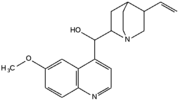Quinine
|
|
Quinine, C20H24N2O2, is a natural white crystalline alkaloid having antipyretic, anti-malarial and analgesic properties and a bitter taste. It is a stereoisomer of quinidine.
Quinine was the specific agent used in the treatment of malaria until it was supplanted by more effective synthetic drugs like quinacrine, chloroquine, and primaquine. Quinine may still be used to treat resistant malaria, nocturnal leg cramps and arthritis. It was also used in an attempt to treat people who had been infected by prions, but with only limited success.
The theorized mechanism of action for Quinine and related anti-malarial drugs is that these drugs are toxic to the malaria parasite, specifically by interfering with the parasites ability to degrade and digest hemoglobin, thus starving the parasite or causing the build-up of toxic levels of partially degraded hemoglobin in the parasite.
Quinine was extracted from the bark of South_American Cinchona tree, isolated and named in 1820 by French researchers Pierre Joseph Pelletier and Joseph Caventou. The name was derived from the original Quechua (Native American) word for the Cinchona tree bark: "Quina" or "Quina-Quina" means, roughly, "bark of bark" or "holly bark".
The large scale use of Quinine as a prophylactic started around 1850, although it had been used in un-extracted form by Europeans since at least the 17th century. The quinine containing bark of the Cinchona tree (also called Peruvian_Bark) was known for its medical properties by the natives, but did not enter popular knowledge to Europeans until its abilities to combat malaria was discovered. The exact date of this discovery is controversial: malaria was not native to South America, so the natives did not know of this anti-malarial property. In 1742 the barks anti-malarial properties were supposedly discovered by the Countess of Cinchona, when native healers cured her malaria with it, But medical reference and export of the bark had begun up to 200 years earlier.
Cinchona trees remain the only practical source of quinine. However, under wartime pressure, research towards its artificial production was undertaken: A formal chemical synthesis was accomplished in 1944 by R.B. Woodward and W.E. Doering, American chemists. Since then, several more efficient total syntheses have been achieved (see review article in: Angewandte Chemie, Int. Ed., 2005, 44, p. 854 ff), but none of them can compete with isolation of the alkaloid from natural sources, in economical terms.
Use of quinine in therapeutic doses may cause cinchonism; in excessive doses or rare cases, it may even cause death. In very large doses quinine also acts as an abortifacient, or may cause birth defects, especially deafness.
Quinine is a flavour component of tonic water. According to tradition, the bitter taste of antimalarial quinine tonic led British colonials in India to mix it with gin, thus creating the Gin and Tonic cocktail.
However, even if this was the case, today's refreshing gin & tonic is a rather different drink from theirs: the quantity of quinine in a glass of modern-day tonic water is a fraction of that formerly used in treating malaria. In the US, for example, the FDA limits tonic water quinine to 83 ppm which is one half to one quarter the concentration used in therapeutic tonic.
Reactions
Missing image
Quinine_reaction1.png
Image:Quinine reaction1.png
External links
- From intox databank (http://www.intox.org/databank/documents/pharm/quinine/ukpid13.htm)
- From inchem (http://www.inchem.org/documents/pims/pharm/pim464.htm)
- Database file on Quinine from rain-tree.com (http://www.rain-tree.com/quinine.htm)da:Kinin

